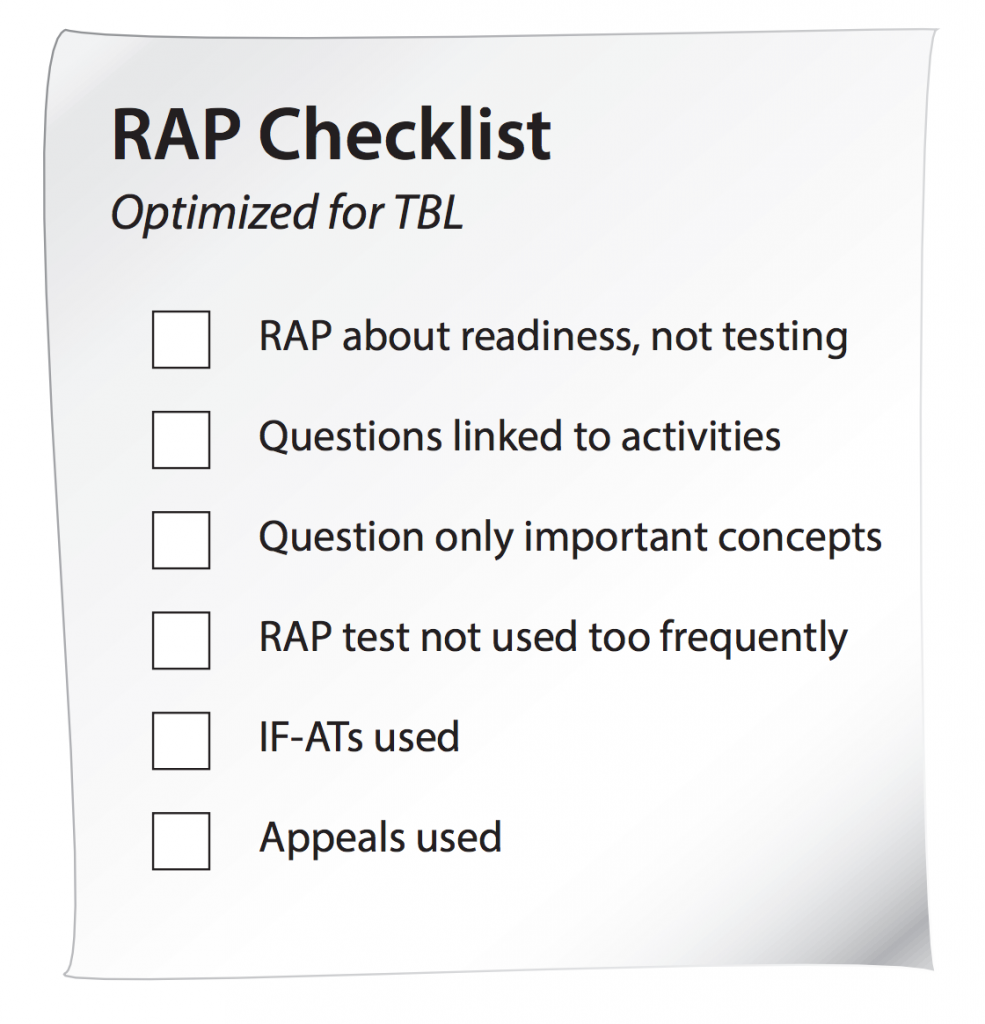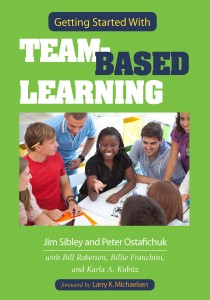Ensuring Student Readiness
Having the students coming to class prepared is critical in order to have any possibility of deeper classroom conversations and meaningful problem-solving activities. Students not only need to be accountable for their initial preparation, but actually need to be ready for the activities. The Readiness Assurance Process lets you change initial preparation into true readiness to begin problem solving.
Overview of the Readiness Assurance Process
The RAP is designed to get your students ready for the upcoming instructional sequence. The Readiness Assurance Process (RAP) is a five-stage process that is used at the beginning of each module in your course. The purpose of the RAP is to ensure that students understand the fundamental concepts, definitions, and foundational knowledge they need to begin problem-solving. The Readiness Assurance Process centers on administering two short multiple-choice tests. The first test is taken individually, and then the same test is taken again by the students in their teams. It sounds simple, but it has powerful results.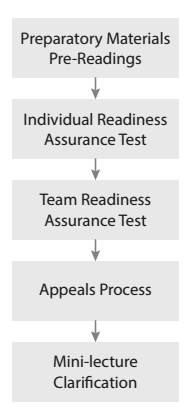
The RAP prepares students for the activities that follow. It is not about testing. Students will become very upset if the RAP is presented just another assessment strategy, rather than preparation for the activities that follow. If the RAP process is not carefully integrated with the activities that follow, you can expect the unhappy student cry of “Testing before teaching makes no sense!” It’s the synergy between the crystal-clear objectives of the instructional sequence, the Readiness Assurance Process, and the Application Activities that follow that gives TBL much of its instructional power.
Let’s start by examining each of the five stages of the Readiness Assurance Process.
Stage 1: Student Pre-class Preparation
Stage 2: Individual Readiness Assurance Test (iRAT)
Stage 3: Team Readiness Assurance Test (tRAT)
Stage 4: Appeals Process
Stage 5: Mini-Lecture/Clarification
Pre-Class Preparation: Readings or other Preparatory Materials
Prior to the beginning of each module, students are assigned readings or other preparatory materials such as newspaper articles, journal articles, textbook chapters, podcasts, PowerPoint slides, or instructional videos. They must study these materials to prepare for the module activities. We typically assign 30-60 pages in preparation for a two-week module. The specific amount of preparatory materials will depend on the difficulty of the material, the discipline, and the institutional culture.
In general, we have found that shorter and more focused readings are better. TBL teachers find that the quality of the reading materials is even more important than in a traditional course, since the students will actually read the course materials!
Individual Readiness Assurance Test
After completing the preparatory materials, students come to the first class session of a TBL instructional sequence or module. They then individually c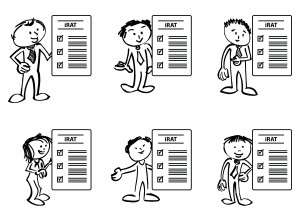 omplete a short 10-20 question multiple-choice test based on the readings. The RAP test is typically closed-book, but some teachers do allow short summaries on index cards. However, teachers should be mindful that high-quality RAT questions are not based on rote memorization or recall. At a very simple level, the Individual Readiness Assurance Test is about individual accountability for pre-class preparation. Did students complete the preparatory materials? The test should focus on giving students the vocabulary and important foundational concepts they need to successfully begin problem-solving. Using the analogy of a book, the test should be constructed closer to the table-of-contents level than the index level. It is recommended that you stay away from picky details, and focus only on important major concepts. However, iRAT questions should still be fairly challenging. Overall, the average student score is typically 65-75% on the iRAT and 85-95% on the tRAT.
omplete a short 10-20 question multiple-choice test based on the readings. The RAP test is typically closed-book, but some teachers do allow short summaries on index cards. However, teachers should be mindful that high-quality RAT questions are not based on rote memorization or recall. At a very simple level, the Individual Readiness Assurance Test is about individual accountability for pre-class preparation. Did students complete the preparatory materials? The test should focus on giving students the vocabulary and important foundational concepts they need to successfully begin problem-solving. Using the analogy of a book, the test should be constructed closer to the table-of-contents level than the index level. It is recommended that you stay away from picky details, and focus only on important major concepts. However, iRAT questions should still be fairly challenging. Overall, the average student score is typically 65-75% on the iRAT and 85-95% on the tRAT.
Team Readiness Assurance Test (tRAT)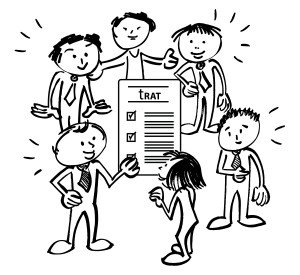
The team RAP test, or tRAT, begins immediately after the iRAT. The exact same questions are used for both tests.
Team tests are high-energy, noisy, and often chaotic events as students discuss and negotiate their answers and deepen their understanding. Typically, we budget 25 minutes for a 20-question team test, although we let students know that when half of the teams are done, the remaining teams have five minutes left to finish.
A special kind of scoring sheet, known as an IF-AT form (Immediate Feedback Assessment Technique), is typically used for the team tests. IF-ATs are ”scratch-and-win”-style scoring sheets. They dramatically increase the quality of discussion in the tRAT process and, more importantly, provide rich, immediate corrective feedback. Students absolutely love using these test cards. You can expect high-fives and cheering as students complete the tRAT. We have even had some students thank us for the test! If you have not tried these, you must!
Appeals Process
The appeals process is a structured method that provokes teams into looking up answers they got wrong on the tRAT. Near the end of the tRAT process, the teacher circulates around the room and encourage teams that may have gotten an answer wrong on the tRAT to consider appealing the question. The teams use an appeals form that is included in their folder. The form describes in detail how to make a successful written appeal. Appeals are only accepted from teams, not individuals. To appeal a question successfully, the team needs to build a written rationale that makes a case, supported with evidence, for why a particular question’s answer might be wrong. They can declare ambiguity in either the question or in the readings. To support their case, they must make specific citations to the source of the ambiguity, or reword the question to eliminate the ambiguity.
Mini-Lecture/Clarification
Following the appeals process, the teacher can, if necessary, provide a short, targeted mini-lecture or clarification on the RAP concepts that the students are still having difficulty with. This lets teachers focus just on what the students don’t know, rather than on what they already know. Students are often anxious to begin the Application Activities. Going over every question or talking for too long can burn up student goodwill. A common mistake made by new TBL teachers is to sequentially review every question. Don’t do it. This can quickly drain energy from the class.
The total RAP process takes 50-70 minutes for a 20-question test. In shorter classes, teachers will often shorten the RAP test. For our 50-minute classes, we often give 12-15 questions; this gives us time to complete the entire five-stage process.
Why the RAP is so powerful (aka important)
Pre-class Preparation Outcomes
The pre-class preparatory materials you select can significantly help focus student attention on the most salient course concepts. Using a reading guide can be of even further benefit. It is important to remember this is not students’ only opportunity to learn course content. During the problem-solving Application Activities, they will continue learning. The students are motivated by their own interest and the knowledge that their understanding will be on public display during the Application Activity reporting. This is a powerful motivator for students to take learning seriously.
Individual Readiness Assurance Outcomes
The iRAT can accomplish a few different things. Its main purpose is to have individual accountability for each student’s pre-class preparation. Simply put, if you don’t prepare, you probably won’t do well on the iRAT. The focus of the Readiness Assurance Process also cues students to the most important course concepts. If confidence testing is used, there is also an interesting metacognitive component, where students might admit to themselves that they really don’t know something. This can be a powerful motivator to have them reconsider their preparation strategy for next time.
Team Readiness Assurance Outcomes
During the tRAT stage, some very interesting educational outcomes begin to emerge. First, through social dialogue and peer teaching, students generate a deeper shared understanding as they try to come to a consensus on the answer for a particular question. Next, if you are using IF-AT cards, the teams receive immediate corrective feedback on each question. Students leave the test knowing the answer to every question; you can’t get more immediate than that!
The IF-AT cards also help establish more positive group norms. The pushy student with the wrong answer may be a few scratches away from having the team stop listening. Similarly, a quiet student can be drawn into the conversation if the team recognizes that they often have the right answers and that listening to the quiet student will help the team. Finally, the chronically underprepared student is usually found out by their teammates, and peer pressure and peer evaluation can sometimes motivate these underprepared students to work harder.
Another powerful piece of team testing is the levelling process that occurs between team mates. Having team members at different levels of preparation and understanding can be quite toxic to team activities. The team test serves to get each team member on the “same page” with peer teaching, consensus building, and the fact that every person knows the answer to every question by the end of the RAP test, thereby helping all team mates become more evenly ready. Turning individual preparation into true team readiness to begin problem solving is what the readiness assurance process is about.
Appeals Process Outcomes
The magic of the appeals process is that it pushes students back into the reading or other preparatory material, right where they are having the most difficulty. These difficulties are clearly identified by questions they got wrong on the tRAT. Teams must look up the concepts they still don’t understand. They may research the answer only to find that the teacher is correct, or they may unearth a genuine ambiguity. They need to build the appeal by reviewing both the preparatory material and the question, and by building a case supported with evidence.
Mini-Lecture/Clarification Outcomes
At the end of the first four stages, both student and teacher have a clearer understanding of which course concepts continue to be difficult. The students have had extensive feedback during the tRAT process and an opportunity with the appeals process to clear up any misconceptions. But some troublesome concepts can remain. These can be clarified during the short mini-lecture that closes out the Readiness Assurance Process. The power is that the clarification focuses on what the students know they don’t know. It doesn’t waste class time on things they already understand.
A word of caution: Teachers new to TBL often fall in love with the structures and outcomes of the Readiness Assurance Process, and may think about just implementing the RAP and not the rest of the pieces of TBL. This is a serious mistake, since the main goal of TBL is to help students use course concepts to solve significant problems, which occurs during the Application Activities. The RAP is about getting your students ready. If you only use the RAP in your course, students can legitimately complain about testing before teaching. If you only use the RAP process, what are you getting students ready for?
Excerpted from a 39 page chapter on the Readiness Assurance Process in Getting Started with Team-Based Learning by Jim Sibley and Pete Ostafichuk published by Stylus, Sterling, VA
Buy the book from Stylus Publishing Buy the book from Amazon
